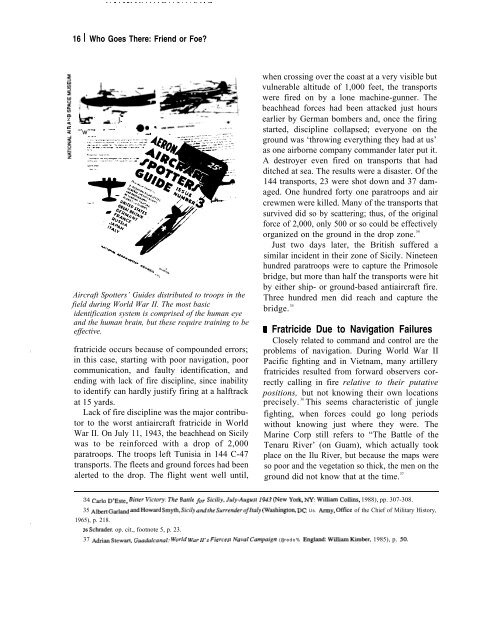Who Goes There: Friend or Foe? - Federation of American Scientists
Who Goes There: Friend or Foe? - Federation of American Scientists
Who Goes There: Friend or Foe? - Federation of American Scientists
You also want an ePaper? Increase the reach of your titles
YUMPU automatically turns print PDFs into web optimized ePapers that Google loves.
. . . . - -- - .- . - . - -- - - -- . - - -- - - —<br />
16 I <strong>Who</strong> <strong>Goes</strong> <strong>There</strong>: <strong>Friend</strong> <strong>or</strong> <strong>Foe</strong>?<br />
!*<br />
u);”<br />
n<br />
z< kzr . &. - .. J-<br />
Cr<br />
. . co ‘<br />
z “’w’’”* ‘“ ““”” . . ,4 ., ,<br />
*OU %, %,;*<br />
‘+, “<br />
Aircraft Spotters’ Guides distributed to troops in the<br />
field during W<strong>or</strong>ld War II. The most basic<br />
identification system is comprised <strong>of</strong> the human eye<br />
and the human brain, but these require training to be<br />
effective.<br />
fratricide occurs because <strong>of</strong> compounded err<strong>or</strong>s;<br />
in this case, starting with po<strong>or</strong> navigation, po<strong>or</strong><br />
communication, and faulty identification, and<br />
ending with lack <strong>of</strong> fire discipline, since inability<br />
to identify can hardly justify firing at a halftrack<br />
at 15 yards.<br />
Lack <strong>of</strong> fire discipline was the maj<strong>or</strong> contribut<strong>or</strong><br />
to the w<strong>or</strong>st antiaircraft fratricide in W<strong>or</strong>ld<br />
War II. On July 11, 1943, the beachhead on Sicily<br />
was to be reinf<strong>or</strong>ced with a drop <strong>of</strong> 2,000<br />
paratroops. The troops left Tunisia in 144 C-47<br />
transp<strong>or</strong>ts. The fleets and ground f<strong>or</strong>ces had been<br />
alerted to the drop. The flight went well until,<br />
when crossing over the coast at a very visible but<br />
vulnerable altitude <strong>of</strong> 1,000 feet, the transp<strong>or</strong>ts<br />
were fired on by a lone machine-gunner. The<br />
beachhead f<strong>or</strong>ces had been attacked just hours<br />
earlier by German bombers and, once the firing<br />
started, discipline collapsed; everyone on the<br />
ground was ‘throwing everything they had at us’<br />
as one airb<strong>or</strong>ne company commander later put it.<br />
A destroyer even fired on transp<strong>or</strong>ts that had<br />
ditched at sea. The results were a disaster. Of the<br />
144 transp<strong>or</strong>ts, 23 were shot down and 37 damaged.<br />
One hundred f<strong>or</strong>ty one paratroops and air<br />
crewmen were killed. Many <strong>of</strong> the transp<strong>or</strong>ts that<br />
survived did so by scattering; thus, <strong>of</strong> the <strong>or</strong>iginal<br />
f<strong>or</strong>ce <strong>of</strong> 2,000, only 500 <strong>or</strong> so could be effectively<br />
<strong>or</strong>ganized on the ground in the drop zone. 34<br />
Just two days later, the British suffered a<br />
similar incident in their zone <strong>of</strong> Sicily. Nineteen<br />
hundred paratroops were to capture the Primosole<br />
bridge, but m<strong>or</strong>e than half the transp<strong>or</strong>ts were hit<br />
by either ship- <strong>or</strong> ground-based antiaircraft fire.<br />
Three hundred men did reach and capture the<br />
bridge. 35<br />
I Fratricide Due to Navigation Failures<br />
Closely related to command and control are the<br />
problems <strong>of</strong> navigation. During W<strong>or</strong>ld War II<br />
Pacific fighting and in Vietnam, many artillery<br />
fratricides resulted from f<strong>or</strong>ward observers c<strong>or</strong>rectly<br />
calling in fire relative to their putative<br />
positions, but not knowing their own locations<br />
precisely. 36<br />
This seems characteristic <strong>of</strong> jungle<br />
fighting, when f<strong>or</strong>ces could go long periods<br />
without knowing just where they were. The<br />
Marine C<strong>or</strong>p still refers to “The Battle <strong>of</strong> the<br />
Tenaru River’ (on Guam), which actually took<br />
place on the Ilu River, but because the maps were<br />
so po<strong>or</strong> and the vegetation so thick, the men on the<br />
ground did not know that at the time. 37<br />
34 (XUlo r)’)ZSte, Bitter Vic(ov: The B~tr/e f<strong>or</strong> Siciliy, Ju/y-A~g~Sr J$)43 mew Y<strong>or</strong>k NY: William cobs, 1988), pp. 307-308.<br />
35 A&fiGml~d ~dHowmd smy~,si~i/y ~~thesurrender<strong>of</strong>]taly (was~gtou Dc: Us. Army, Office <strong>of</strong> the Chief <strong>of</strong> Military Hist<strong>or</strong>y,<br />
1965), p. 218.<br />
36 Sckader, op. cit., footnote 5, p. 23.<br />
37 ~fim stew- Gw&l~ana[: W<strong>or</strong>ld War II’S Fier~e~t Naval campaign (@redo% l%gl~d: Willi~ Kimber, 1985), p. 50.
















